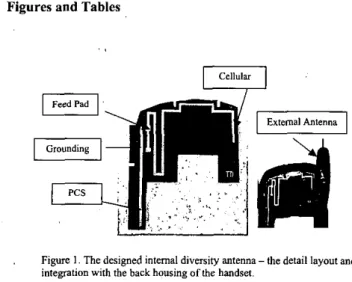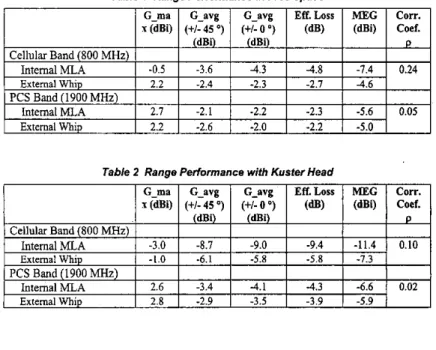Feasible Diversity Antenna Design for Dual Band Mobile
Handsets
Yi-Cheng Lin
Department of Electrical Engineering National Taiwan University, Taipei, Taiwan
yclin@cc.ee.ntu.edu.tw
1. Introduction
Capacity improvements can be achieved in a CDMA cellular system through the use of handsets equipped with dual anlennaslreceivers [l-21. Signals received by each antennas are manipulated using various combining algorithms in the data processing in order to improve the overall received signal to interference plus
noise ratio (RX SINR). The RX SINR directly impacts the amount of forward link power required from the cellular basestation. Users with improved SINR require less power to serve them, thereby allowing more users to be served in a cell. Hence the overall system capacity is improved.
The intent ofthis study is to demonstrate the feasibility ofthe diversity antenna design for existing commercial handsets and to evaluate the potential capacity improvements using field test data measured in a real cellular network.
2. Antenna Design
In general, the antenna performance of handsets is sensitive to the near components associated with specific boundary condition. Therefore, the antenna design should take into account the effect of the handset platform including the circuit board configuration, battery, and plastic cover. In this shldy, the mobile handset Qualcomm QCP-2700 was selected as the platform for the developed diversity antenna.
Since the dual antennas are designed for a receive diversity handset in the forward link, the function of one antenna must be for transmit and receive denoted as the primaly antenna, and the other is for receive only, denoted as the secondaly antenna.
QCP-2700 handset has an existing whip antenna operating at US Cell band 824 to 894 MHz and PCS band1850 to 1990 MHz. This antenna was considered as the primary antenna operating for transmit and receive. The work on this antenna was simply to fine ne the impedance matching after adding the secondaly antenna The secondary antenna was designed as an internal antenna. The meander line type of inverted F antenna was built on a thin flexible board, as shown in Figure
.
I . The dual band feahlre was realized by dividing the trace into two arms ~ one
for PCS and the other for Cell band. The two traces share the common feed and grounding pads that are connected the circuit board through the pogo pins. The distance between the feed and grounding points was optimally selected such that the input impedance is 50 ohms at both resonant frequencies. The simulation tool IE3D was employed in this study. The measured re" loss is shown in Figure 2.
3. Chamber Tests
The developed handset prototype was first tested in the anechoic chamber. The antenna was mounted on a two-axis positioner fixture that can generate the 3D patterns of the antenna.
The antenna gain patterns were based on the total fields combining vertical and horizontal polarized components. The test parameters of interest include the following:
8
G-max: the peak of the antenna gain over the entire sphere.
G-avg(+/@): the spatial average of the total field antenna gain over the conic region of +I- 0' about the horizon plane.
Efficiency Loss: the equivalent antenna loss obtained by integrating the whole sphere 3D patterns. Note that Efficiency Loss equals C-avg(+/- 90"). MEG and Correlation Coeflicient p: the estimated mean effective gain and the complex voltage envelop correlation coefficient ofthe dual antennas using the measured antenna patterns (complex polarimetric data) and Taga's statistical models of the incident fields [3]. The following urban parameters were used in the calculation:
mddeg) = 19,
c
z
(deg) = 20, mh(deg) = 32, q, (deg) = 64, and XPR= 5dB The definitionsof
testing environments are listed as follow:Free Space: only the antenna itself is tested in the anechoic chamber Kuster Head: the antenna is attached to a plastic phantom head containing liquid simulating human brain tissue.
Tables I and 2 summarize the radiation performance of the prototype in free space and on Kuster Head, respectively. Data show that the head loss has less
impact on Whip than MLA at Cellular band. Data also show that the external Whip antenna outperforms the internal MLA about 4 dB at Cellular band, while only slightly better at PCS band
4.
Conclusions
In this study, a feasible diversity antenna design is demonstrated on a dual band commercial handset. The meander line inverted F antenna is designed, implemented, and tested. A good rule of thumb derived from these results is to
limit the average gain of the secondary (internal) antenna to be no less than 6 dB lower than that of the primary (external) antenna when the phone is in talk position next to the user’s head. This was used as a performance goal for the design of diversity antennas
Reference:
I.“CDMA forward link capacity improvements with dual-antenna handsets,” QC DCN# 80-H0567-1
2 . 1 . Colburn, Y. Rahmat-Samii, M. Jensen, and G. Pattie,”Evaluation ofpersonal communications dual-antenna handset diversity performance”, IEEE Trans. Antena Propagat., vol. 41, pp.737-746, Aug. 1998.
3. K. Fujimoto and J.R. James, “Mobile Antenna Systems Handbook,” Section 2.4, Artech House, 2“d ed, 2000.
Figures and Tables
,Figure 1. The designed intemal diversity antenna - the detail layout and the integration with the back housing ofthe handset.
Table 1 Range Performance in Free Space
Coef.
Table 2 Range Performance with Kuster Head

